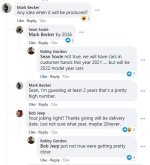WTF! Are you guys egging me on to post on this thread or just this dumb!
Im going to assume no ones dumb, and just does not know or understands a production line or how something gets put into production.
The cars you see are factory pre production cars using production parts, assembled by hand. Not actually on a moving assembly line. In most cases this is done directly at the factory, in a designated R&D or pre production dept. building or area. This is how all pre production products are done. Every brand & model of UTV or anything with multiple pieces are done like this. Years ago their was a leaked photo of the Turbo S on a pre production setup plate being assembled. It can take days or weeks to assemble a vehicle. Where as on an assembly line your doing dozens to thousands of units a day depending on what your building. (Example; Taylor guitar’s Tecate Mexico plant produces 800 guitars a day!) Robby said they are expecting to build 40 vehicles a day per line. With the goal of 2 lines running producing 80 cars a day. Ford produces over a 1000 trucks a day, and they still hand assembled their pre production & R&D trucks.
First on a pre production unit, you are checking tooling and to see final fitment. When green lighted and put on a full assembly line, the parts & pieces have to fit right. You can’t stop a line to file or clean a cast or fitting. Some of the welds on the pre production cars will not pass, and they have noted that from the chassis dept, all the way to this pre production assembly. Like Robby & Todd have said the factory will keep working on the robot welders to perfect and meet standard.
Two during this fitment and assembly process. Manufacturing and assembly line engineers are looking at what order parts have to be attached to the chassis as it moves down the line. What parts are needed to install a single part, like what bolt, bracket or zip tie is needed at that point to mount the intended part. This is called Kitting.
Then they look at what can be assembled on sub assembly lines. Engines, trans, difs, wiring harnesses, shocks. All theses are built & assembled on sub assembly lines, then staged to be put into order for the final assembly line. Also these pieces are all hand assembled or built.
Another thing assembly line engineers & project managers are looking at. Pre assembly kitting. For example, the front bulkhead. It might be more efficient to have the rack, arms, spindles tie rods brakes etc. mounted to the front bulkhead first and plugged into the chassis at one time. Or maybe that’s too big & bulky to stage or swing into the moving assembly line. So the arms might have to be installed later on the line after the bulkhead is installed in the chassis. But then you need hardware on the line to attach the arms. And you now have to have axles, spindles, brakes etc on the line. (More kitting) This is what a production assembly team is looking at.
Then you have quality control engineers looking at the finished individual parts, how those mate up with other finished components. Example, Is the welded bracket on the chassis for the door hinge in the right location. Does the hinge bolt up to the bracket correctly? Do they have the right bolts, and what direction do the bolts install? Then does the molded plastic door properly bolt up to hinge that mounts to the chassis and what order does this happen? Is the door handle pre assembled on the door, or done when fitted on the vehicle? Does the striker latch line up with all that? See the chain that each piece has to fit? Your not putting doors on before the floorboards are installed.
So what you are seeing in the Speed pictures is not an assembly line. This is not how they will be assembling each car. They will be on a true assembly line just like Henry Ford designed.
Here is a video of how Honda assembles their UTV & ATV’s. Notice the engines are pre assembled, or how the utv bed was sub assembled before being put on the final line to be attached to the vehicle.
https://m.youtube.com/watch?v=JDgcG6dL8xM
I’m out!


